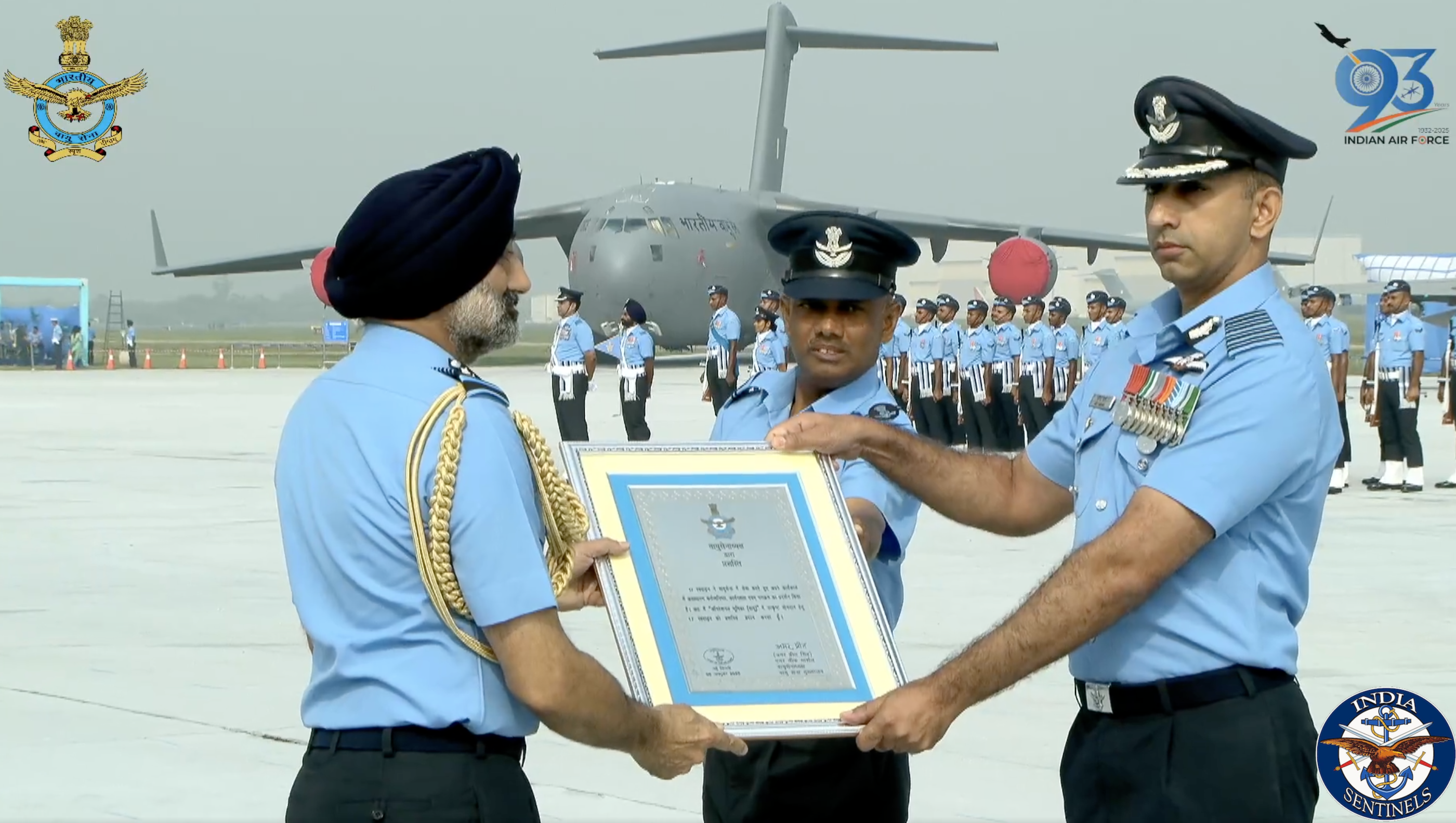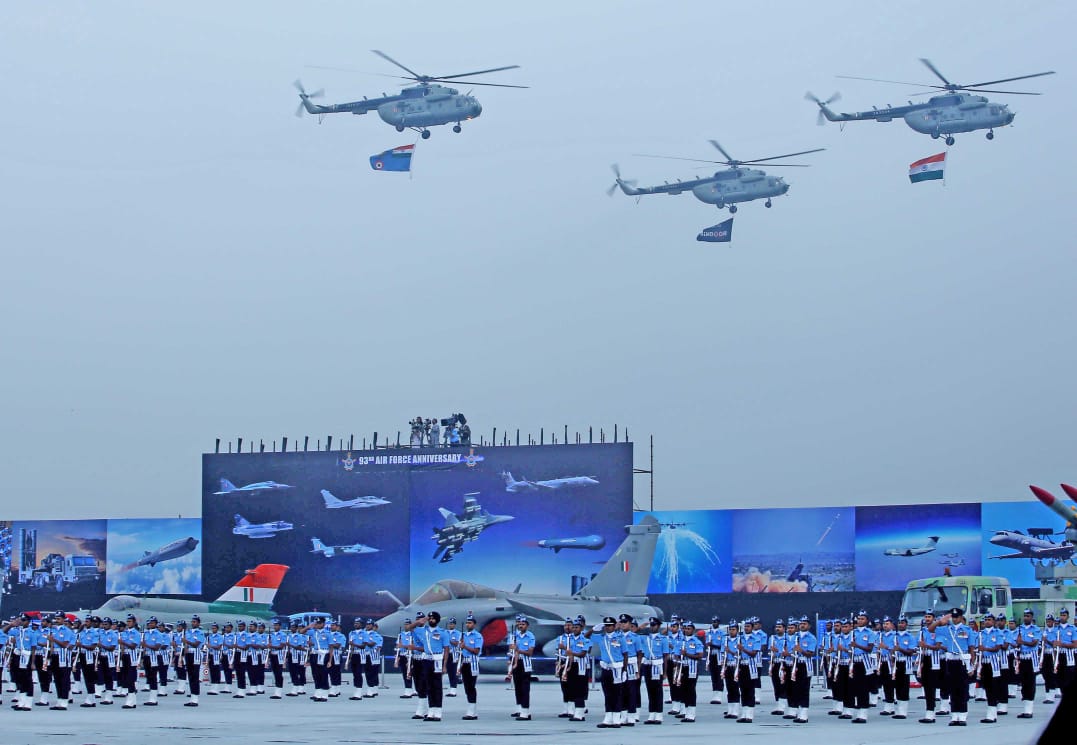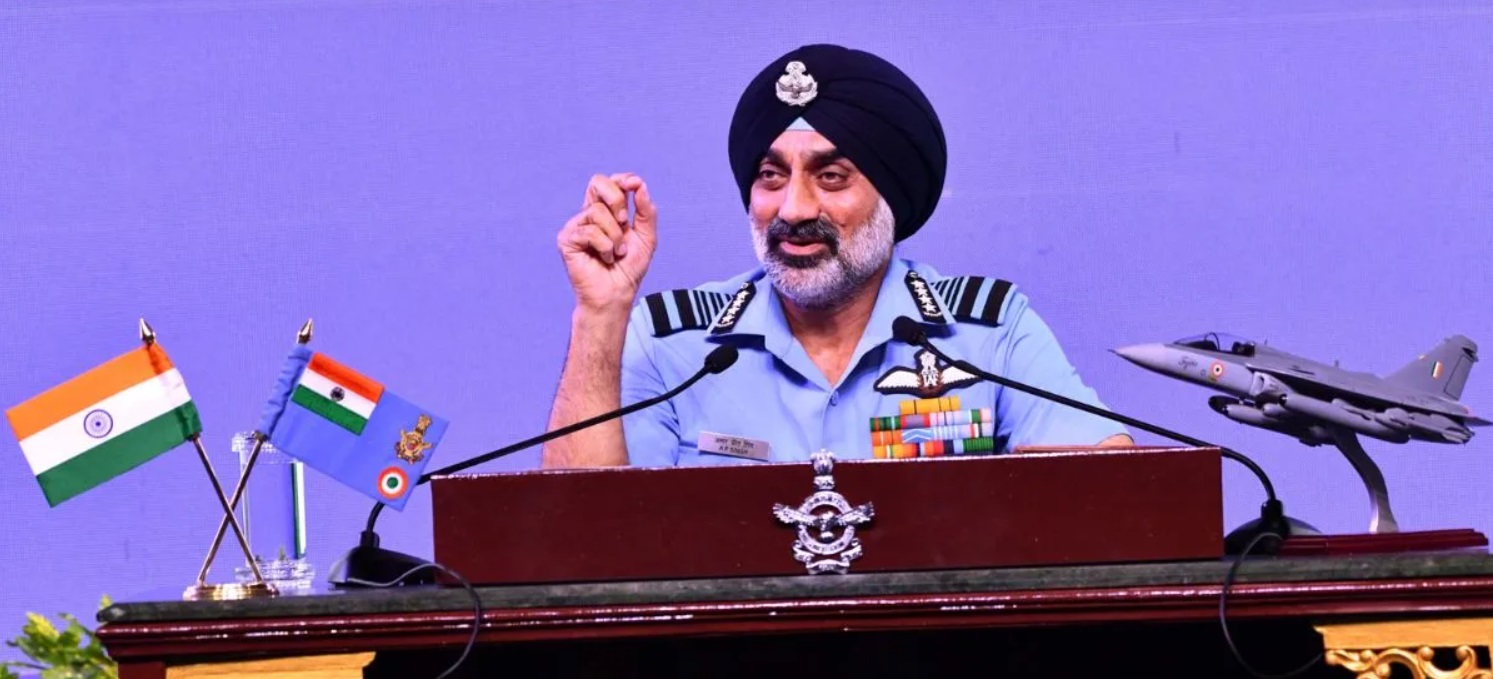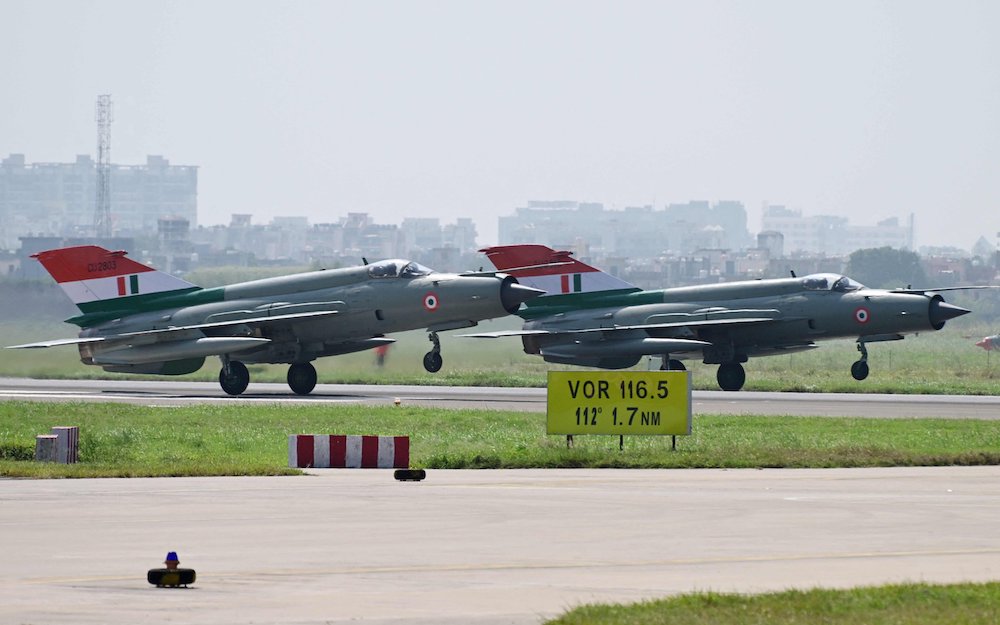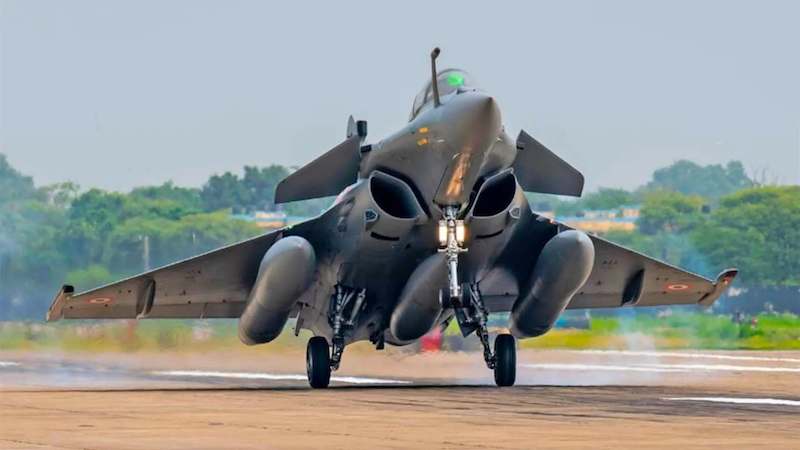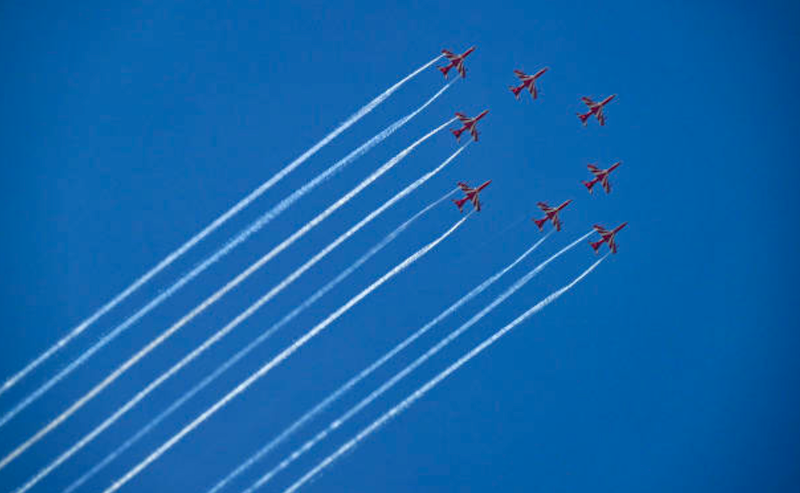 BAE Hawk Mk-132s from IAF’s Surya Kiran Acrobatic Team during an airshow held at Chennai’s Marina Beach, on October 7, 2024.
BAE Hawk Mk-132s from IAF’s Surya Kiran Acrobatic Team during an airshow held at Chennai’s Marina Beach, on October 7, 2024.
“Nabhaḥ Spr̥śaṁ Dīptam (Touch the Sky with Glory)”
~ Indian Air Force Motto
Today is October 8. Each year, on this day, India celebrates the Indian Air Force Day to mark the raising of the service’s first squadron, and honours those brave airmen who served the nation with valour and distinction. What began as a humble auxiliary force under British rule, the Indian Air Force has evolved into one of the world’s most formidable air arms, distinguished by its diverse roles, including combat operations, humanitarian missions, and technological advancements.
So, let’s know a little more about the Indian Air Force, trace its history, contributions, and transformations of the service from its inception, 92 years ago, to the present day as the guardian of our skies.
Background and History
The Indian Air Force (IAF) was officially established on October 8, 1932 as an auxiliary air force of the British Empire, under the Indian Air Force Act XIV, passed by the Indian legislature of the British Raj. The inception of the IAF was a result of the recommendations made by the Skeen Committee, which was tasked with examining the demands for the Indianization of the Indian Army.
The IAF began with a modest fleet of four Westland Wapiti biplanes and a small cadre of six officers and 19 airmen. The first squadron – No. 1 Squadron – was raised on April 1, 1933, under the command of Flight Lieutenant (later Air Vice Marshal) Cecil Bouchier of the Royal Air Force.
The first five pilots commissioned into the IAF were Harish Chandra Sircar, Subroto Mukerjee, Bhupendra Singh, Aizad Baksh Awan and Amarjeet Singh. A sixth officer, JN Tandon, had to revert to logistics duties as he was too short. All of them were commissioned as pilot officers in 1932 from RAF Cranwell.
Later, Subroto Mukherjee became the first Indian chief of air staff.
IAF in World War II
During World War II (Second World War), the IAF played a crucial role in the Allied war effort. The war was its first foray into major global conflict.
Initially tasked with reconnaissance and support roles, the IAF played a crucial part in the Burma Campaign, using outdated aircraft, like the Hawker Hurricane and later Spitfires. During the campaign, the IAF provided vital air support against Japanese forces. Notable feats include the actions of No. 1 Squadron, which flew tactical reconnaissance missions and low-level attacks on Japanese airbases.
Indian pilots displayed exceptional bravery, flying numerous missions over hostile territory. Among them was Flying Officer Arjan Singh, who later became the first Marshal of the Indian Air Force. By the end of the war, the IAF had expanded to 28,500 personnel and over 1,200 aircraft, gaining recognition for its prowess in the Southeast Asian theatre.
Distinguished pilots such as Squadron Leader Arjan Singh, who later became the Marshal of the Indian Air Force, earned accolades for their bravery and skill. By the end of the war, the IAF had grown to a strength of nine squadrons and had been awarded the prefix “Royal” in recognition of its contributions.
Evolution and Development Post-War
Post-World War II, the IAF underwent significant modernization and expansion. The transition to independence in 1947 marked a new chapter for the IAF, which retained the “Royal” prefix until India became a republic in 1950.
The Parliament enacted a new Indian Air Force Act in 1950, which is the law under which the IAF operates today.
The IAF’s fleet was modernized with the induction of aircraft, such as the Hawker Tempest and the de Havilland Vampire, making it the first Asian air force to operate jet fighters. The establishment of training institutions and the acquisition of advanced aircraft laid the foundation for the IAF’s future growth.
Impact of Partition and Post-Independence Evolution
The Partition of India in 1947 had a profound impact on the IAF. The division of assets and personnel between India and Pakistan posed significant challenges. Despite these hurdles, the IAF quickly adapted and played a pivotal role in the first Indo-Pakistani War of 1947-48, providing crucial air support during the conflict in Kashmir.
This period also marked the IAF’s shift from British leadership to Indian command, symbolizing the country’s growing independence in military affairs. Gradually, the following years saw the IAF evolve into a formidable force, with the induction of aircraft such as the MiG-21 and the establishment of new squadrons.
IAF in Post-Independence Wars
The IAF’s role in India’s subsequent conflicts cemented its place as a crucial pillar of national security. It played key roles in the following wars:
* 1962 India-China War: Although the IAF didn’t participate in direct combat, the service provided crucial airlift and logistical support in the difficult terrains of the Himalayas, including high-altitude battlefields in Ladakh.
* 1965 India-Pakistan War: The IAF’s fighter jets, including the Hawker Hunter and Folland Gnat, played a major role in air battles, notably in the defence of airbases in Punjab.
* 1971 India-Pakistani War: The IAF’s finest hour came during the Bangladesh Liberation War in 1971, where it achieved air superiority over East Pakistan (now Bangladesh), contributing to a decisive victory.
* 1999 Kargil Conflict: The IAF named its Kargil combat campaign as Operation Safed Sagar, in which the service employed precision strikes using various aircraft, like the Mirage 2000, MiG-27, MiG-21, and Mi-17 attack helicopters, to neutralize enemy positions in the Kargil sector. This was a milestone in India’s use of airpower in high-altitude warfare.
Humanitarian Assistance and Disaster Relief (HADR) Operations
The IAF has been instrumental in humanitarian assistance and disaster relief (HADR) operations. Notable missions include Operation Megh Rahat in 2013, where the IAF conducted extensive rescue and relief operations during the Uttarakhand floods. In 2015, the IAF played a key role in Operation Maitri, providing aid and evacuating people following the devastating earthquake in Nepal. The IAF has also been involved in evacuating Indian citizens from conflict zones, such as during Operation Rahat in Yemen, in 2015.
IAF and Indian Space Programme
The IAF has played a pivotal role in India’s space ventures, contributing expertise, personnel, and infrastructure to various space missions. India’s first astronaut, Squadron Leader (later Wing Commander) Rakesh Sharma, became a national hero when he flew aboard the Soviet spacecraft Soyuz T-11 in 1984.
His journey was a testament to the collaboration between the Indian Space Research Organization (Isro) and the IAF, with Sqn Ldr Sharma selected from a pool of Indian Air Force pilots, which included Wing Commander Ravish Malhotra, for his historic space mission.
Building on this legacy, the IAF continues to support India’s ambitious space endeavours, which includes the Gaganyaan mission. The Gaganyaan programme aims to send Indian astronauts, or “Gaganyatris” into space in India’s first manned spaceflight. The IAF played a crucial role in selecting the four candidates – all of whom are IAF fighter pilots – and training them in collaboration with Isro.
The selected four IAF pilots are currently undergoing rigorous physical, psychological, and technical training to prepare for the demands of spaceflight. The IAF’s medical and technical expertise is essential to ensuring the safety and readiness of the crew.
This partnership between the IAF and Isro showcases India’s evolving aerospace capabilities, merging the strength of military aviation with the ambitions of space exploration.
Distinguished IAF Officers and Airmen
Over the decades, the IAF has produced numerous gallant officers whose leadership and bravery have become part of its legacy. One of the most revered figures is Marshal of the Air Force Arjan Singh, who led the IAF during the 1965 war and was later honoured with the five-star rank, making him a towering figure in Indian military history.
Other distinguished officers include:
* Flying Officer Nirmal Jit Singh Sekhon: He awarded the Param Vir Chakra posthumously for his valour during the 1971 war, when he single-handedly engaged enemy Sabre jets.
* Squadron Leader Ajay Ahuja: He was awarded the Vir Chakra posthumously for his actions during the Kargil War when his aircraft was shot down while trying to locate a downed pilot.
Indian Air Force Today
Today, the Indian Air Force stands as one of the world’s most formidable air forces. Its inventory includes:
* Fighter Aircraft – Sukhoi Su-30MKI, Dassault Rafale, MiG-29, Mirage 2000, and the indigenous Tejas LCA (light combat aircraft).
* Helicopters – Apache AH-64E, Chinook, Mi-17V5, and indigenous platforms, like the Dhruv ALH (advanced light helicopter), Prachand LCH (light combat helicopter), Cheetah, and Chetak.
* Transport Aircraft – C-17 Globemaster, C-130J Super Hercules, and Ilyushin Il-76, An-32.
* Mid-Air Refuellers – Ilyushin Il-78 tankers extend the range of the IAF’s fighters.
* Reconnaissance and Surveillance – Unmanned aerial vehicles (drones), like the Heron, and satellite-based systems enhance the IAF’s surveillance capabilities.
Apart from the above, the IAF operates several advanced radar, missile, and air-defence units, like the S-400. Also, there are several new aircraft and drones on order, which the IAF will have in its inventory soon. It will also get advanced indigenously built fighters, such as advanced versions of the Tejas and AMCA in the coming years.
The Indian Air Force’s journey from its inception in 1932 to its current status as a cutting-edge military force is a testament to its resilience, adaptability, and commitment to the defence of the nation. From its humble beginnings with a handful of aircraft, the IAF has grown into a highly professional force, capable of defending India's skies, projecting power, and providing humanitarian assistance on a global scale.
Its legacy, built by distinguished officers and airmen, continues to inspire future generations, ensuring that it remains a symbol of pride and honour for India.
Read also: Gunners’ Day – Let’s know about Indian Army’s Regiment of Artillery
Follow us on social media for quick updates, new photos, videos, and more.
X: https://x.com/indiasentinels
Facebook: https://facebook.com/indiasentinels
Instagram: https://instagram.com/indiasentinels
YouTube: https://youtube.com/indiasentinels
© India Sentinels 2024-25





